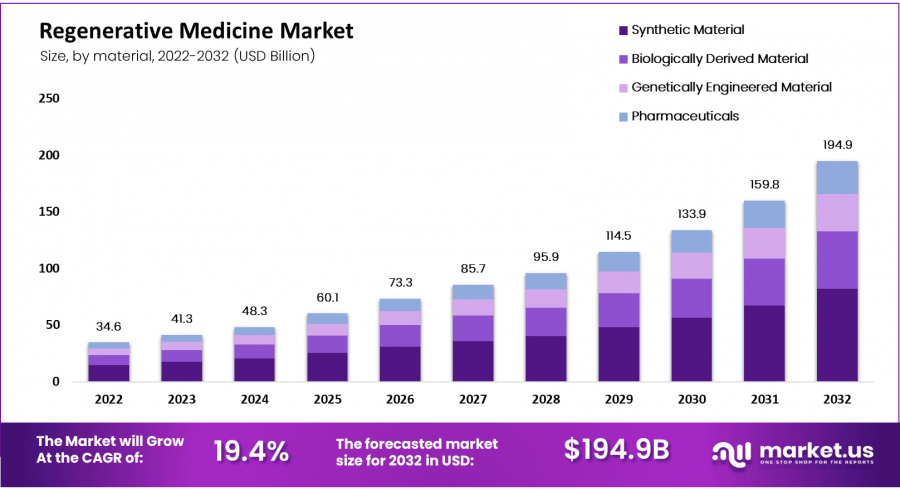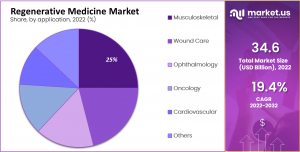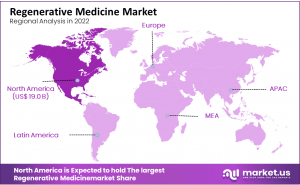
Regenerative Medicine Market: Poised for 19.40% CAGR Growth
Regenerative Medicine Market size is expected to reach USD 194.9 Billion by 2032 from USD 34.6 Billion in 2022, growing at a CAGR of 19.40% from 2023 to 2032.
NEW YORK, NY, UNITED STATES, January 24, 2025 /EINPresswire.com/ -- The Global Regenerative Medicine Market is projected to reach USD 194.9 billion by 2032, up from USD 34.6 billion in 2022, with a CAGR of 19.40% during the forecast period. This growth is primarily driven by technological advancements, such as 3D bioprinting and stem cell therapy. These innovations enhance treatment precision and efficacy in tissue and organ regeneration, addressing various medical conditions.
Furthermore, the rising prevalence of chronic diseases and genetic disorders fuels the demand for innovative treatments. Regenerative medicine, with its potential to repair or replace damaged cells and tissues, offers promising cures that are increasingly sought after by patients and healthcare providers alike. This demand is shaping the market's expansion and influencing research directions.
Support from government and healthcare organizations also significantly impacts the sector's growth. Agencies like the U.S. National Institutes of Health (NIH) play a crucial role by funding research and facilitating the development of regenerative therapies. Such support helps accelerate the translation of biomedical discoveries into practical applications, benefiting patient care.
Lastly, collaborations between academia and industry are pivotal in advancing regenerative medicine. These partnerships not only refine technologies but also scale them for broader clinical use, thus improving patient access to advanced treatments. The synergy between these entities ensures continuous innovation and effective commercialization of regenerative therapies, promising sustained growth in the market.
Get Sample PDF Report: https://market.us/report/regenerative-medicine-market/request-sample/
Key Takeaway
• The Regenerative Medicine Market is projected to reach USD 194.9 billion by 2032, from USD 34.6 billion in 2022.
• Annual growth of 19.4% is anticipated from 2023 to 2032 in this market.
• Biological therapies are increasingly preferred over traditional treatments in regenerative medicine.
• The COVID-19 pandemic disrupted CAR T-cell therapy delivery and related research.
• Demand for regenerative medicine is driven by chronic diseases like cancer, diabetes, and heart disease.
• Advances in stem cell research are significantly contributing to the market's growth.
• An increasing elderly population is spurring demand for regenerative treatments.
• Government investments in regenerative medicine research are escalating.
• High costs pose significant barriers to the widespread adoption of regenerative treatments.
• Ethical concerns and regulatory challenges arise from the use of controversial cell sources.
• The regulatory approval process for regenerative therapies is intricate and lengthy.
• The market sees opportunities in personalized medicine using patients’ own cells and tissues.
• Growth prospects are evident in emerging markets across Asia, Latin America, and the Middle East.
• Key trends include the use of gene editing tools like CRISPR-Cas9 and 3D printing for tissue engineering.
Segmentation Analysis
In 2022, the synthetic material dominated the regenerative medicine market, holding a 42% share. This segment is valued for its extensive use and innovation potential. Meanwhile, biologically derived materials also significantly impact market dynamics, with projections indicating the fastest growth in terms of CAGR. The pharmaceuticals segment is anticipated to expand due to a robust product pipeline, reflecting broader industry trends towards biotechnological advancements.
The regenerative medicine market serves various applications, with the musculoskeletal segment leading in revenue and market share in 2022. This dominance is driven by the rising incidence of bone injuries. Conversely, the oncology segment is poised for rapid growth, expecting the highest CAGR during the forecast period. However, areas like ophthalmology, wound care, and cardiovascular are experiencing slower growth due to limited research and development efforts.
Cell therapy emerged as the largest segment within regenerative medicine, commanding a 24% revenue share in 2022. Its predominance is attributed to its applications in treating diseases such as cancer, infectious diseases, and joint injuries. Additionally, the gene therapy segment is forecasted to experience significant growth, underpinned by its high CAGR and promising advancements in genetic engineering.
Hospitals and clinics are the primary end-users in the regenerative medicine market, benefiting from the highest revenue share and growth projections. This segment's growth is fueled by an increase in surgical procedures and strong governmental support through various initiatives. In contrast, commercial and academic sectors are projected to grow more slowly, hindered by stringent R&D eligibility criteria in research institutions.
Based on the Therapy Type
• Cell Therapy
• Gene Therapy
• Tissue Engineering
• Small Molecule
• Biologic
• Progenitor
• Stem Cell Therapies
• Other Therapies
Based on Material
• Synthetic Material
• Biologically Derived Material
• Genetically Engineered Material
• Pharmaceuticals
Based on Application
• Wound Care
• Musculoskeletal
• Ophthalmology
• Oncology
• Cardiovascular
• Others
Based on End User
• Hospitals & Clinics
• Commercial Industries
• Government & Academic Research Institutes
Regional Analysis
North America holds a dominant position in the global regenerative medicine market, accounting for a 52% market share. This region's substantial market size is fueled by robust government and private funding dedicated to research and development. The supportive funding environment is instrumental in advancing regenerative medicine technologies and applications, securing North America's lead in the market.
In terms of growth rate, North America is also anticipated to register a high compound annual growth rate (CAGR) during the forecast period. The ongoing investments in innovative technologies and the region's established healthcare infrastructure are key contributors to this growth. These factors collectively enhance the region's capacity to innovate and expand in the regenerative medicine field.
Meanwhile, the Asia Pacific region is identified as having high growth potential within the regenerative medicine market. Expected to expand at a CAGR of 26.6%, it remains poised for rapid growth throughout the forecast period. This region's growth is propelled by increasing healthcare expenditures and a rising focus on cutting-edge medical research, making it a critical area for market expansion.
Europe holds the second-largest share in the global regenerative medicine market, primarily driven by a high demand for organ transplants and advancements in tissue engineering. The region's well-established medical infrastructure and strong regulatory frameworks support a steady demand for regenerative treatments, maintaining Europe's significant role in the global market landscape.
Buy Directly: https://market.us/purchase-report/?report_id=22139
Market Players Analysis
Emerging key players in the regenerative medicine market are adopting diverse strategic approaches to enhance their business footprints in international markets. A focus on expanding current operations and research and development facilities is central to their growth strategies. This expansion is not just about increasing size but also about enhancing technological capabilities and innovation potential in global markets.
Additionally, companies within this sector are actively engaging in new product development and broadening their portfolios. Investment in these areas is robust, supported by strategic mergers and acquisitions. These moves are designed to solidify market presence and extend reach across various healthcare segments.
Moreover, marketing strategies are also evolving among regenerative medicine enterprises. Key players are now increasingly promoting the benefits of natural ingredients within their product lines. This marketing tactic aims to educate and inform consumers about the advantages of natural components, thereby driving product demand and market growth.
This focus on natural ingredients is more than a trend; it represents a shift towards sustainability and health-consciousness in product development. As consumers become more aware of the health impacts of their choices, they are more likely to opt for products that align with these values. Thus, emphasizing natural ingredients not only caters to current consumer preferences but also sets the stage for sustained growth in the regenerative medicine market.
The Primary Entities Identified In This Report Are:
• AstraZeneca plc
• F Hoffmann-La Roche Ltd
• Integra Lifesciences Corp
• Astellas Pharma Inc
• Cook Biotech Inc
• Bayer AG
• Pfizer Inc
• Merck KGaA
• Abbott
• Vericel Corp
• Novartis AG
• GlaxoSmithKline (GSK)
• Baxter International Inc
• Boehringer Ingelheim
• Amgen Inc
• Cesca Therapeutics Inc
• U S Stem Cell Inc
• Bristol-Myers Squibb
• Eli Lilly and Company
• NuVasive Inc
• Organogenesis Inc
• MiMedx Group Inc
• Takara Bio Inc
• Osiris Therapeutics Inc
• Corline Biomedical AB
• Other Key Players
Emerging Trends in Regenerative Medicine
Patient-First Approach: There's a growing shift toward a patient-centric model in regenerative medicine. This involves tailoring treatments to individual patient needs right from the development stage, promising more effective and safer outcomes.
Microrobotics: These tiny robots are being developed to deliver drugs with high precision directly to targeted areas like tumor sites. This could revolutionize treatments for conditions such as cancer and cardiovascular diseases.
Advanced Biomaterials: Breakthroughs in biocompatible materials are enabling the creation of sophisticated implants and even bioengineered organs, with 3D bioprinting playing a significant role in these developments.
AI and Machine Learning: AI technologies are significantly speeding up drug discovery and enabling more precise disease diagnostics. AI is also facilitating the development of personalized medical interventions, including novel mRNA vaccines.
Gene Editing and CRISPR: Innovations in gene editing, particularly through CRISPR technology, are poised to treat genetic disorders more effectively, with advancements expected in delivery systems like lipid nanoparticles.
Cell-Free Therapies: These therapies utilize the beneficial products of cells without the risks associated with transplanting whole cells, increasingly applied in areas like sports medicine and chronic disease management.
Use Cases of Regenerative Medicine
Tailored Tissue Solutions: Surgeons are increasingly using custom-designed biomaterials for complex surgeries, such as the separation of conjoined twins, leading to better patient outcomes and recovery experiences.
Drug Delivery Systems: Microrobots could soon be used in clinical settings to deliver medications directly to affected areas, reducing side effects and improving treatment efficacy for diseases like cancer.
Organ Transplantation: 3D bioprinting and advanced biomaterials are being used to create vascularized tissues, which are critical for developing fully functional, transplantable organs.
Personalized Medicine: AI-driven tools are being developed to analyze large datasets from genomics and other biometrics to tailor treatments to individual genetic profiles, enhancing the effectiveness of treatments for serious diseases like cancer.
Gene Therapy: CRISPR technologies are being adapted for mainstream medical use, potentially providing cures for diseases such as sickle cell anemia and cystic fibrosis by correcting genetic defects at their source.
Enhanced Recovery in Sports Medicine: Cell-free therapies are proving valuable in helping athletes recover more quickly from injuries by stimulating the body's natural repair mechanisms without the complications of traditional stem cell therapies.
These trends and use cases highlight the dynamic nature of regenerative medicine, as it incorporates cutting-edge technologies to address complex medical challenges, offering new hope for personalized and effective treatments.
Buy Directly: https://market.us/purchase-report/?report_id=22139
*We offer customized market research reports tailored to meet your specific business needs and requirements.
Lawrence John
Prudour
+91 91308 55334
Lawrence@prudour.com
Distribution channels: Healthcare & Pharmaceuticals Industry
Legal Disclaimer:
EIN Presswire provides this news content "as is" without warranty of any kind. We do not accept any responsibility or liability for the accuracy, content, images, videos, licenses, completeness, legality, or reliability of the information contained in this article. If you have any complaints or copyright issues related to this article, kindly contact the author above.
Submit your press release


